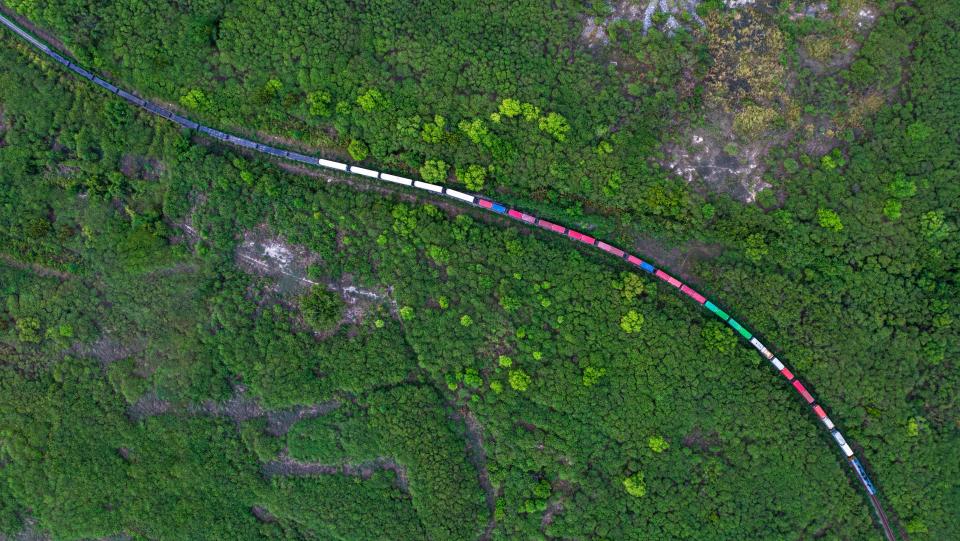Sierra Club still sees rail as ‘a climate solution’

More than 15 years after it was first produced, the Sierra Club has revised its statement on how to promote clean transportation within the rail space.
For the grassroots environmental organization, 2023 marked an opportune moment to revise the statement, which looks at how passenger and freight railroads can reduce and minimize their greenhouse gas emissions. The Infrastructure Investment and Jobs Act (IIJA), which President Joe Biden signed into law in November 2021, encourages the U.S. Department of Transportation and other related agencies such as the Federal Railroad Administration (FRA) to pursue ways to encourage states and local communities to adopt transportation options that address climate change or emissions reductions.
Following passage of the IIJA, FRA developed an initiative in April 2022 spurring the industry to address climate change and achieve net-zero greenhouse gas emissions by 2050. The agency also appointed staff to address issues related to climate change and resiliency.
“Given this historic investment and given the stark reality that we are seeing the effects of climate change, we felt that it would be appropriate to update the statement and really use it as a resource, [particularly for those] who are interested in getting involved in advocacy,” Katherine García, director of the Sierra Club’s Clean Transportation for All campaign, told FreightWaves.
García’s role is to ensure that everyone in the U.S. has access to clean mobility. That includes access not only to zero-emitting cars, trucks and buses but also encouraging communities to promote walking or biking.
“And really, the point of the statement is to say that rail is a climate solution, and we want to make sure that it’s well invested and that the investments really benefit communities across the country,” García continued.
According to García, the Sierra Club first published its rail transportation statement in 2007. The organization revised its statement and released it in August.
To revise the rail statement, García relied on volunteers who she said are “very passionate” about rail, as well as local and state chapters that might be active in rail initiatives, such as those in California.
According to a summary of the statement, Sierra Club recommends the following actions for freight rail: Call for all levels of government to take an intermodal approach to transportation policies as a means to ensure safe, energy-efficient and cost-effective freight movements; urge U.S. officials to adopt European-style open access rail policies; and call upon DOT and FRA to develop a comprehensive training program for railroad personnel.
Sierra Club also supports efforts by the California Air Resources Board (CARB) to pass regulation calling for zero-emission locomotives over the next two decades. The regulation — which is facing some legal pushback from the freight rail industry in part because of the aggressive timeline prescribed in the new rule — calls for switch, industrial and passenger locomotives built in 2030 or after to operate in zero-emissions configurations, while locomotives built in 2035 for freight linehaul operations will need to comply with zero-emissions configurations. CARB defines zero-emission configurations as a zero-emission locomotive or a zero-emission-capable locomotive.
“The standard is long overdue and we’re seeing it as a blueprint for other states,” García said.
While the rail industry has looked at deploying more battery-electric locomotives and hydrogen-powered locomotives as ways to reduce locomotive emissions, García and the rail statement say the ultimate goal should be electrification of the freight rail system in the U.S. Fuels like biodiesel serve as a bridge fuel, García said, and so rather than supporting bridge fuels, regulatory focus should be on electrification.
“Unlike aviation, which will be very difficult to move away from petroleum fuels, rail can convert to electricity generated from clean sources in the grid like hydroelectric, wind, solar, and geothermal. Electric trains can use regenerative braking, and directly feed power to the motors,” the rail statement said. “It is also far easier and more energy efficient to electrify trains than trucks, particularly for long-haul trucks which would have to stop to charge every couple hundred miles on long-distance trips.”
Garcia said the Sierra Club supports the use of green hydrogen from renewable sources, because even though it is more expensive, it does rely upon dirty sources to produce hydrogen.
“What we’re really calling out is that the majority of trains run on diesel, [which] causes a significant burden on communities that are around rail yards, and so we really want to make sure that we’re putting policies in place that will reduce those emissions around the rail yards,” she said.
Ultimately, Sierra Club sees its revised statement as something environmental advocates can use to rally around when pursuing local, state and federal initiatives.
“The Sierra Club has been working in coalition with environmental justice partners to … [promote] a shift from trucks to rail. We want to reduce traffic congestion on the highways and reduce diesel emissions” from the movement of goods, García said.
The statement’s summary said: “All levels of government need to recognize the importance of robust rail transportation for both passenger and freight. In the near term, cities, counties, states and tribes can leverage grant opportunities such as those offered by the Infrastructure Investment and Jobs Act. Because most federal grant opportunities require matching funds, it is important for these levels of government to have well-developed project plans that are ready for construction when funding becomes available.”
Subscribe to FreightWaves’ e-newsletters and get the latest insights on freight right in your inbox.
Click here for more FreightWaves articles by Joanna Marsh.
Related links:
The post Sierra Club still sees rail as ‘a climate solution’ appeared first on FreightWaves.
